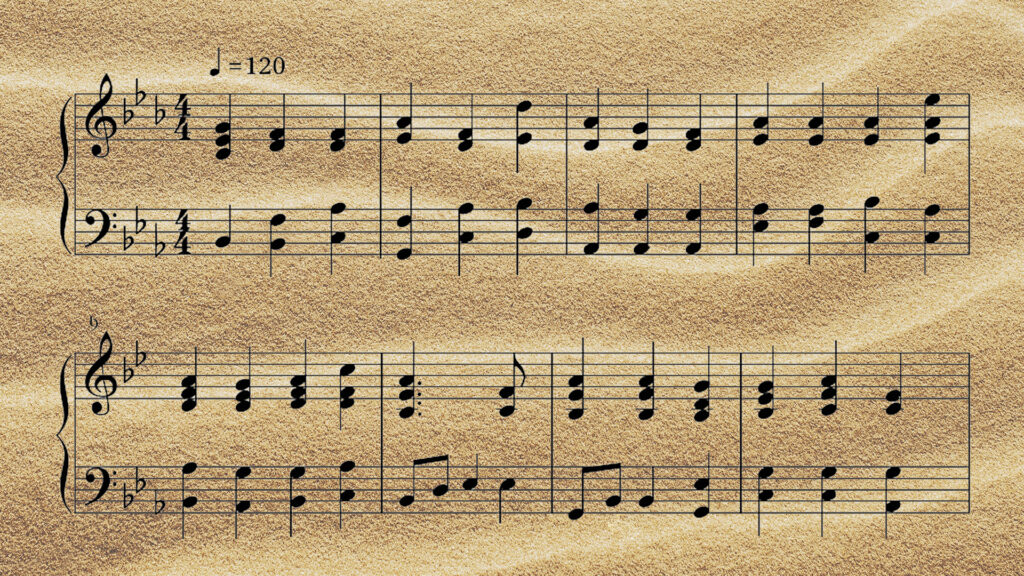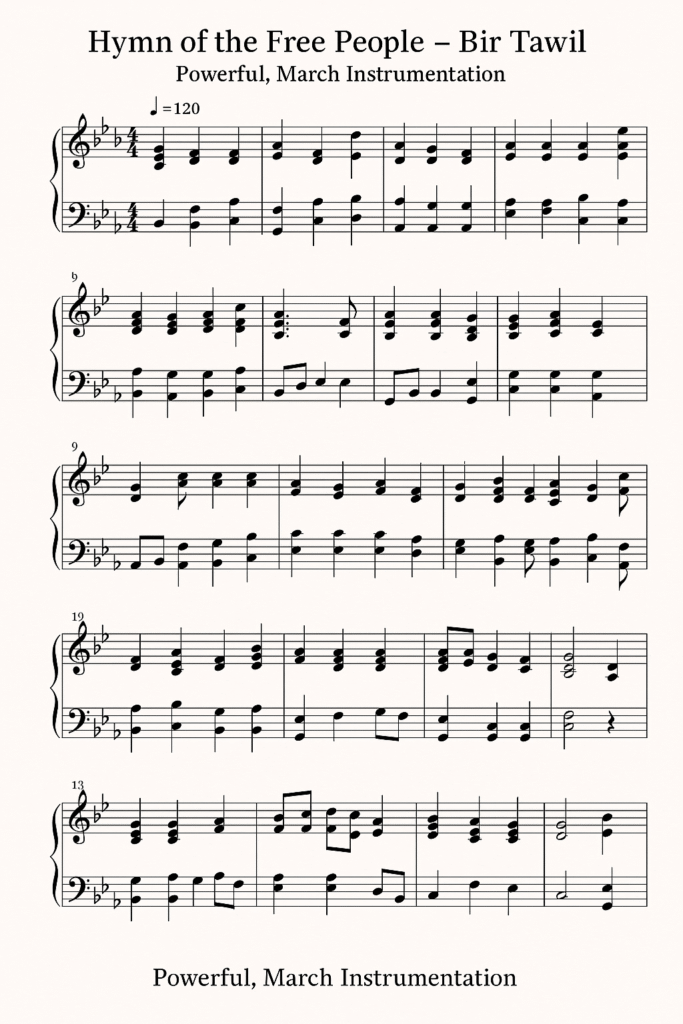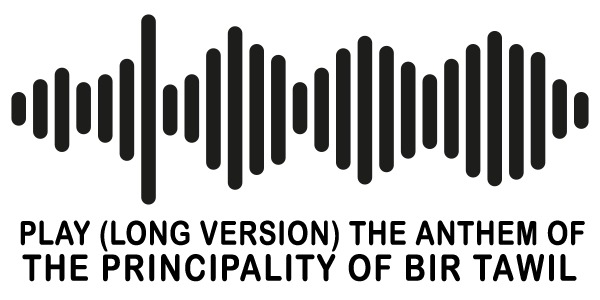

The Anthem of the Free People, of the Principality of Bir Tawil, is much more than a musical composition — it is the ode to the freedom of peoples
With the cadence of a march, the Anthem of the Free People of the Principality of Bir Tawil is a declaration of identity and a living symbol of freedom. From the first drum roll, its sound calls for unity and pride, like an echo stretching from the eternal dunes to the open horizon of the desert. Each verse evokes the essence of the Principality of Bir Tawil: a land without walls or chains, where the people’s voice is the only authority and hope becomes a flag.
Its firm and ascending notes invite all to walk together, hand in hand, across sands that hold promises of the future. The powerful, repetitive chorus is a universal call to defend the chosen land, proclaiming that here, freedom is not a distant ideal but a daily right. The slower, solemn bridge offers a pause that prepares the listener for the final climax, where orchestra and percussion merge in an explosion of strength and determination.
The longest version of this anthem lasts 2 minutes and 40 seconds—enough time to lift the spirit and ignite a sense of belonging in any official ceremony or community gathering. Official and ceremonial version is 60 seconds. Unlike traditional anthems that glorify war, this piece celebrates cooperation, resilience, and self-determination, portraying the Principality of Bir Tawil as a chosen home, a beacon of hope, and a symbol of the light the world forgot.
A national anthem represents, for any nation, a sound symbol of identity, unity, and collective pride. The Anthem of the Free People, of the Principality of Bir Tawil, is a musical and literary expression that condenses its history, values, and aspirations, and, when performed, strengthens the sense of belonging and cohesion among its citizens.

Anthem of the Free People – Bir Tawil (March Anthem)
From the sands, we rise.
For the people, for freedom — Bir Tawil forever!
From the dunes where the bright winds call,
Bir Tawil opens arms to all.
No walls, no chains, no ruler’s claim,
Only our voices, free as flame.
People stand! — where the borders fade!
Raise your hands! — for the land we’ve made!
We are the light the world forgot,
Bir Tawil, our chosen spot!
For the hearts that seek open skies,
For the hands that will build and rise,
We march as one on this timeless sand,
Side by side, hand in hand.
People stand! — where the borders fade!
Raise your hands! — for the land we’ve made!
We are the light the world forgot,
Bir Tawil, our chosen spot!
Through the storm and the restless years,
We hold fast, we cast off fears.
Freedom’s song will guide our way,
Bir Tawil — here we’ll stay!
People stand! — where the borders fade!
Raise your hands! — for the land we’ve made!
We are the light the world forgot,
Bir Tawil, our chosen spot!
Bir Tawil… our chosen spot!

Hamid Adam – Composer of the Bir Tawil Principality National Anthem
Hamid Adam is a United Arab Emirates–based music producer and composer, celebrated for his ability to create anthems, cinematic scores, and bespoke soundtracks. Known for blending artistic creativity with precise sound design, he delivers music that is both powerful and emotionally resonant.
With a career serving clients across the globe, Hamid tailors each production to reflect the unique vision of the project. His passion for cultural and thematic compositions allows him to adapt seamlessly across genres, from grand orchestral arrangements to modern soundscapes.
Driven by a commitment to inspire and connect through music, Hamid’s work leaves a lasting impression—an approach clearly embodied in his composition of the National Anthem of the Principality of Bir Tawil.
The most beautiful, longest, and shortest national anthems in the world
The flag waves with pride, but it is the national anthem that lifts collective identity to new heights. This musical and literary piece is far more than a ceremonial accompaniment; it is a sonic symbol of unity, history, and pride that emotionally connects citizens to their nation. The length of an anthem not only determines its duration but also reflects the depth with which a country has woven its values into the musical fabric.
In the realm of extensive national anthems, Greece, Uruguay, and Chile shine with imposing compositions capable of immersing listeners in patriotic narratives of great complexity. In 2017, the British outlet The Economist published a list of the twelve best anthems in the world. South Africa ranked first, followed by Russia. Uruguay’s anthem achieved a remarkable third place, and Brazil took fourth.
The history of Argentina’s anthem is a good example of how these pieces can change over time. Its original version, composed by Vicente López y Planes with music by Blas Parera, lasted about twenty minutes and included harsh verses against Spain, such as references to the “haughty Iberian lion” and the “fierce oppressor of the Fatherland.” Over time, these stanzas were removed, and the shortened version was approved by the General Constituent Assembly on May 11, 1813.
Whether lasting several minutes or only a few seconds, a national anthem’s length is more than a matter of bars—it is a reflection of a people’s history, aspirations, and values. The longer ones can narrate battles and epic deeds; the shorter ones can convey centuries of tradition in just a few words.
The Anthem to Liberty of Greece and Japan’s Kimigayo
In Europe, the longest national anthem belongs to Greece. Its Anthem to Liberty, written in 1823 by Dionysios Solomos and set to music by Nikolaos Mantzaros, consists of 158 stanzas—632 verses—that recount the Greek people’s struggle during the War of Independence. Performed in full, it becomes a monumental choral work; however, in official events, only a shortened version lasting about one minute and twenty-five seconds is usually sung.
In South America, Uruguay has the longest national anthem in terms of usual performance time. Also known as Ode to Liberty, it was composed by Francisco José Debali with lyrics by Francisco Esteban Acuña de Figueroa. Its 105 bars translate into approximately six minutes of music, expressing the history and values that have shaped Uruguay’s identity.
Chile, with music by Ramón Carnicer and lyrics by Eusebio Lillo, joins the group of long anthems. Its Himno Nacional is a sonic testimony to crucial episodes in the nation’s history, transmitting solemnity and patriotic pride in every note.
On the opposite end, Japan offers Kimigayo, the shortest national anthem in the world. With just four lines and thirty-two characters, it condenses the essence of Japanese culture into a soft, solemn melody lasting about a minute and a half. Its message is simple yet profound: a wish for eternal peace and prosperity under the reign of the Emperor, considered the symbol of the State.
In all cases, each anthem is the soundtrack of a nation and, together with its flag, an emblem that stirs emotions and strengthens collective identity.




